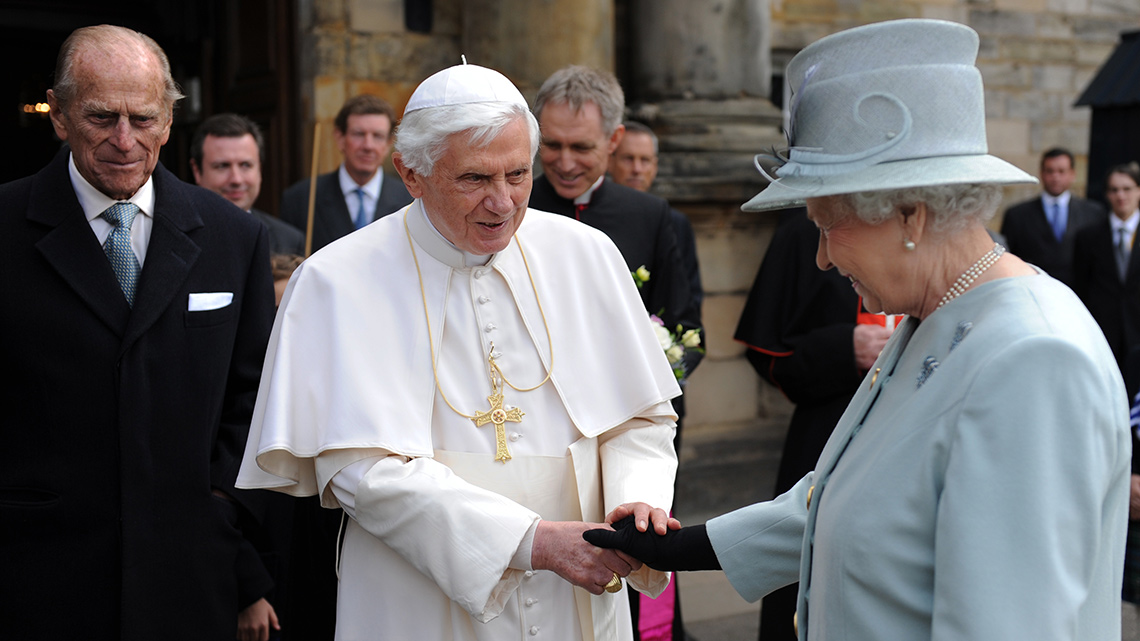A brief history of Catholicism and the Kings and Queens of Great Britain from 16th - 19th Century.

The Pope is not only the religious leader on earth of the Catholic Church: he is also a head of state. For centuries there had been many disputes between kings and bishops, Popes and Emperors, especially as bishops were also great landowners and ministers of the Crown. In 1521 Henry VIII wrote a book against Luther, for which Pope Leo X gave him the title (still on British coins as ‘F.D.’) of ‘Defender of the Faith’. But St Thomas More, who was later beheaded for supporting the authority of the Pope, thought that Henry had been too enthusiastic in his account of it. ‘The Pope is a prince, as you are’, he said: ‘it may hereafter fall out that your Grace and he may vary’. In 1535, after Henry had declared himself Supreme Head of the Church in England, Pope Paul III excommunicated him (deprive of the right of Church membership) and declared him deposed. There was a theory that a pope, as head of the Christian commonwealth, could do this to an unjust king—though such a change of regime could only be effective if another king was willing and able to enforce it by invasion. In this case it was not effective, though there are still reminders of the threat in the castles which Henry built to defend the harbours along the south coast.
In 1570 Pope St Pius V excommunicated Henry’s younger daughter Elizabeth I and declared her deposed for her suppression of Catholicism in England. But Philip II of Spain was not going to invade England in order to replace Elizabeth (who was his sister-in-law and whom he had offered to marry himself) by the next heir, Mary Queen of Scots, who was half-French. In 1580 Pius V’s successor Gregory XIII had suspended the bull because of representations by English Catholics about the impossible situation that it left them in. In 1587 Mary Queen of Scots was beheaded, leaving her claim to the English throne, not to her son James VI of Scotland but to Philip II. In 1588 the Spanish Armada attempted to invade England but was defeated by a combination of fire-ships and storms. Almost all English Catholics supported Elizabeth, and even Pope Sixtus V doubted whether it would be beneficial for the Church if the Armada succeeded, since Philip regarded himself as a sort of vice-Pope for his own vast domains on both sides of the Atlantic. Nevertheless, the bull of 1570 had still not been withdrawn, and the Elizabethan government tried to entrap prisoners by what was called the ‘Bloody Question’: if the Pope, for the restoration of the Catholic religion, invaded England, or authorised some other ruler to do so, whose side would you fight on?
In 1603 Elizabeth died and James VI of Scotland succeeded her as James I of England. Although James was a Protestant, he had never, unlike Elizabeth, been a Catholic. Pope Paul V therefore ordered English Catholics to give their support to James, who for his part suspended the laws against Catholics and began negotiations to end the war with Spain. But after only a year the laws were reimposed, and in November 1605 they were apparently justified by the Gunpowder Plot. This left a lasting impression that Catholics could not be loyal subjects. It was celebrated by a special service for 5 November, which included a prayer against ‘our cruel Popish enemies who delight in blood’ and was in use until it was suppressed by Queen Victoria in 1856.
In the later years of James I (d. 1625) and under his son Charles I the persecution of Catholics eased; in the 1630s there were even Papal agents in London and discussions about possible reunion. During the Civil Wars (1642-48) many Catholics fought for the King; in 1651 his son Charles II owed his life after the Battle of Worcester to the priest-holes in Catholic houses. He never forgot this and after his restoration in 1660 did what he could to protect the Catholics. James I, Charles I and Charles II all had Catholic wives; Charles II became a Catholic on his deathbed, and his brother James II (1685-88) was already a Catholic when he succeeded. But in 1688 he was removed and replaced by his Protestant daughter and son-in-law William III and Mary II. An Act of 1689 provided that no one who was a Catholic or married to one could be sovereign.
In 1714, Mary II’s sister, Queen Anne, was succeeded by a distant cousin, George I from Hanover, though most Catholics still regarded James II’s son (‘James III’) as the lawful king. But when ‘James III’ died in 1766, the Pope refused to recognise his son (‘Bonnie Prince Charlie) as ‘Charles III’; and Charles’s brother, the ‘Duke of York’ who would have become ‘Henry IX’ in 1788, was a cardinal. By then Catholics had accepted George III as the rightful king, a sentiment encouraged by the Catholic Relief Acts of 1778 and 1791. In 1829, by the Catholic Emancipation Act, Catholics recovered most of the rights enjoyed by other British subjects—though the sovereign can still not be, or marry, a Catholic.
For the Pope
God our Father, shepherd and guide,
look with love on Benedict, your servant,
the pastor of your Church.
May his word and example inspire and guide the Church,
and may he, and all those entrusted to his care,
come to the joy of everlasting life.
We ask this through Christ our Lord.
Amen.
Visit a Catholic heritage building, e.g. the ruins of an abbey, house with priest-hole or an old pre-reformation church of Cathedral. Pray regularly for the well-being and needs of Her Majesty, Queen Elizabeth II and her family.
This was written in 2010 by a member of the catechetical team at The Maryvale Institute.